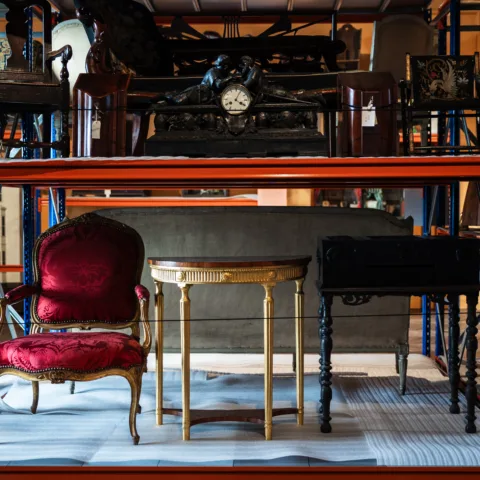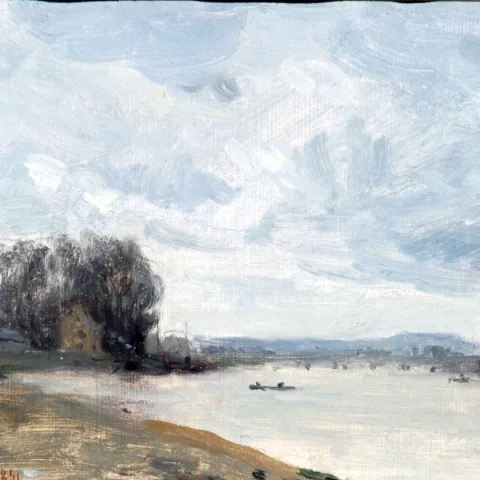The Bowes Museum Blog

Exposing of a Worn Painted Surface
During the last few months a painting has undergone extensive conservation in the Conservation Studio. The painting of interest is a Spanish portrait from the beginning of the 17th century. It is a portrait of Fray José Sigüenza, a Friar and Prior of the Order of Jerome, Librarian at El Escorial, historian and counsellor to the Spanish King, Philip II of Spain. The painting is regarded to be painted by or after Bartholome Carducho, whom at the time did several decorative works at the monastery when Sigüenza lived and worked there. The believed original version of the painting is in the library at El Escorial. The painting belonging to The Bowes Museum was bought by John and Joséphine and has a 415 year old story from its origin in the warm climate of Spain before it ended up in the humid English countryside. After initial examinations it was evident that the painting throughout the years has been restored and treated on several occasions, and once again it is the centre of attention because the condition has become unstable and visually unpleasant.

Photo 1: The painting before conservation. The thick and opaque varnish makes the painting look rather flat and discoloured. Please notice the partly covered Latin text that previously had been covered by overpaint.
The treatments it has recently undergone altered the appearance of the painting dramatically, and I am now going to tell you about the changes that happened. Restoring art is ultimately to impose changes to the aesthetics of the painting, but it may also be of a structural nature when the painting is stabilised by laying down flaking paint. Some professionals and academics might even define conservation as the management of change, and this is an example of a painting undergoing change and how we decided what was going to happen. Actions were taken to reduce the flaking and cupping paint by re-adhering it to the canvas which improved the stability of the painting, but also made a great aesthetic impact as the surface became flat and less visually disintegrated. After the consolidation of the paint and ground layers, the much degraded varnish was removed alongside the removal of darkened, old retouches. After the structural work and the cleaning was done, the stage of restoring the painting began with re-varnishing, infilling of paint losses and retouching to compensate for damages and the lost colours. As hopefully will be revealed later, the changes have been for the good, as the painting again may be viewed by the public. I will now go on to discuss the cleaning of the painting with you.

Photo 2: Flaking paint is carefully laid down and re-adhered to the canvas using a portable mini low-pressure hot table with Isinglass and slight heat.

Photo 3: Before and after consolidation of the flaking paint. Not only is the re-adhering of the paint securing the paint and stabilises the painting structure, it does also have a great visual impact.
The painting has undergone several different treatments and alterations in the past, and layers of varnish have been added as well as several retouches and overpaints. The previous added materials had changed the appearance of the painting to such an extent that the painting looked far from the original image. The varnish was severely oxidised and yellow, almost turning green. The thick and opaque varnish had also changed the tonal variations in the painting, with the bright colours looking yellowed and discoloured whilst the darker colour look duller. It worked as a distortion of a viewer’s perception of depth and the three dimensional qualities of the artist’s original creation. Because of the aging, or the negative changes of the degradation of the varnishes, we decided to remove the varnish layers. The painting had earlier been restored with addition of retouches and overpaint over damages to the original paint layers. The aging of these materials had left them discoloured or darkened compared to the original paint, and several places the restorations were visible and distorted the forms and shapes created by the artist. The materials comprising the old restorations were judged to effect the viewer’s ability to read the image. It was agreed that any overpaint covering the original artist’s paint should be removed in order to bring the appearance of the painting closer to a presumed original state.

Photo 4: Removal of degraded varnish from the once again grey background. Here a gel containing solvents is applied to the surface to swell the varnish before removal.
The objective of the cleaning was to expose as much of the original surface as possible and to remove the secondary materials, meaning materials added by other individuals in various restoration or alteration attempts. By doing this, we could expose the surface of the original materials, and make better decisions about how we truthfully could restore the painting. Although this might sound straightforward, it soon proved to be problematic to achieve a satisfactory result. More time was spent on the cleaning of this painting than estimated, as throughout the process we discovered more overpaints which were hidden underneath the thick varnish and needed to be removed. These materials were not discovered with normal investigation techniques, as the varnish was so thick and degraded. A broad range of methods were used to gently clean the painting, from various solvents on cotton wool swabs, special conservation gels or even a scalpel on occasions. The painting was stripped down of most of the secondary materials that have been added to the painting from previous restorations, except for some of the old filling materials that proved to be in a good state. During cleaning, a much damaged surface was uncovered, exposing paint losses, deep and broad cracks, various abrasions, spots and stains, including various degradation phenomena such as white water insoluble crusts. Especially in the area of script in the bottom part of the painting, not all of the overpaints were possible to remove without the risk of damage to the original paint layers underneath. Towards the end of the cleaning of the script, a microscope was used because it allowed for greater control of the removal of overpaints.

Photo 5: During removal of the yellowed varnish on the sitter’s hand, exposing the bright colour underneath. An abraded dark background was also exposed under layers of overpaints.
Some previous restorations were left because they still functioned as they were supposed to. An example is the old glue paste lining that was not removed, as we could not find any good arguments for taking it away because of the good condition of the lining. Within the theoretical scope of management of change, the decision to not alter something is also a decision that has consequences. To take off the old lining would have meant a lot more of work which necessarily would not be much better than the old, and it would not benefit the painting to a greater extent than the existing lining. The old lining will most likely last until the painting will have to be conserved next time, sometime in the future.

Photo 6: The yellow varnish on the sitter’s face was removed to discover his true expression.
As conservators we impose changes to the objects we restore with the objectives to stabilize the materials as well as the aesthetics and the historic value of paintings. The ways we choose to present pictures are based on various decisions on changes that are made in collaboration with curators and based on a set of professional ethics and guidelines (https://icon.org.uk/system/files/documents/professional-standards-2016.pdf). This is some of the fundamental meanings of management of change as previously mentioned. We try to take the best and most sympathetic decisions, and it is our job to respect the paintings. We all know that age takes its toll and leaves marks on all things, but better cared for objects (or persons) last longer. The same is true for paintings, and we want them to last for as long as possible. That is why we try our best to impose changes we believe are for the better, for the object, when intervention is deemed necessary.
The materials added to the painting, as consolidation adhesives, varnish and retouching mediums, are to the best of the conservation profession’s knowledge meant to last as long as possible as they have been extensively tested by conservation scientists. One effect of this is that the treatments done today are believed to be re-treatable, in the sense that future conservators can remove the materials with methods which are less hazardous to the painting. Secondary materials have been carefully taken off and new, stable materials have been added to the painting throughout the conservation process. The old materials had degraded to such an extent that they were visually unpleasing. The ultimate goal of the cleaning was to remove all of the secondary materials added to the painting after it was completed by the artist, as we judged these alterations had to a great extent changed the visual impact of the painting away from how the painting originally looked like. It is not only the material side of the painting that has changed, but also other values like the artistic and historical dimension of the artwork. The colours are now bright again and covered with a new, synthetic varnish and the balance between the colours created by an artist in Spain 415 years ago are know more true to the original state of the artwork. Also being able to display the painting with the Latin writing has given us invaluable information about the historical context of the sitter.

Photo 7: The painting after removal of varnish and overpaints.
The painting has changed a lot since the work started. Although the painting presented to you now may look to be in a poor state, it is structurally stable and will eventually look presentable again when it is restored and we believe it will be more true to the original state. All the changes the painting has undergone in the last few months has been for the better, because the painting now is in a stable condition and can safely be displayed without the risk of paint falling off. Visitors to the museum will also be able to enjoy the portrait thanks to the aesthetic transformation it has undergone. Conservation as a profession is tightly bound by ethics and guidelines, and all of the stages in the process have been fully documented, with photographs and written records so future generations and conservators can understand the painting and the decision we made in the present.
The conservation of this painting is a perfect example of when something has to look bad before it can look great again. In a forthcoming blog entry I will discuss the visual re-integration of the painting and the Latin text. Please return in a few weeks to see the result of the conservation when the restoration stages are completed.
By Tor Skaaland,
ICON and HLF Painting Conservation Intern







